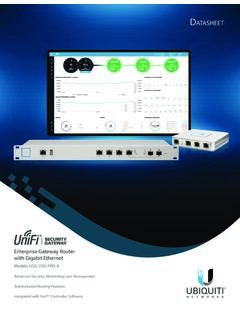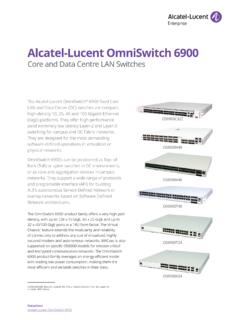Transcription of FIREWALLS - mercury.webster.edu
1 12/3/09 12:15 PM Page 22-1. CHAPTER. FIREWALLS . The Need for FIREWALLS Firewall Characteristics Types of FIREWALLS Packet Filtering Firewall Stateful Inspection FIREWALLS Application-Level Gateway Circuit-Level Gateway Firewall Basing Bastion Host Host-Based FIREWALLS Personal Firewall Firewall Location and Configurations DMZ Networks Virtual Private Networks Distributed FIREWALLS Summary of Firewall Locations and Topologies Recommended Reading and Web Site Key Terms, Review Questions, and Problems 22-1. 12/3/09 12:15 PM Page 22-2. 22-2 CHAPTER 22 / FIREWALLS . The function of a strong position is to make the forces holding it practically unassailable.
2 On War, Carl Von Clausewitz On the day that you take up your command, block the frontier passes, destroy the official tallies, and stop the passage of all emissaries. The Art of War, Sun Tzu KEY POINTS. A firewall forms a barrier through which the traffic going in each direction must pass. A firewall security policy dictates which traffic is authorized to pass in each direction. A firewall may be designed to operate as a filter at the level of IP packets, or may operate at a higher protocol layer. FIREWALLS can be an effective means of protecting a local system or network of systems from network-based security threats while at the same time affording access to the out- side world via wide area networks and the Internet.
3 THE NEED FOR FIREWALLS . Information systems in corporations, government agencies, and other organizations have undergone a steady evolution. The following are notable developments: Centralized data processing system, with a central mainframe supporting a number of directly connected terminals Local area networks (LANs) interconnecting PCs and terminals to each other and the mainframe Premises network, consisting of a number of LANs, interconnecting PCs, servers, and perhaps a mainframe or two Enterprise-wide network, consisting of multiple, geographically distributed premises networks interconnected by a private wide area network (WAN).
4 Internet connectivity, in which the various premises networks all hook into the Internet and may or may not also be connected by a private WAN. Internet connectivity is no longer optional for organizations. The information and services available are essential to the organization. Moreover, individual users within the organization want and need Internet access, and if this is not provided via their LAN, they will use dial-up capability from their PC to an Internet service provider (ISP). However, while Internet access provides benefits to the organization, 12/3/09 12:15 PM Page 22-3.
5 / FIREWALL CHARACTERISTICS 22-3. it enables the outside world to reach and interact with local network assets. This creates a threat to the organization. While it is possible to equip each workstation and server on the premises network with strong security features, such as intrusion protection, this may not be sufficient and in some cases is not cost-effective. Consider a network with hundreds or even thousands of systems, running various operating systems, such as different versions of UNIX and Windows. When a security flaw is discovered, each potentially affected system must be upgraded to fix that flaw.
6 This requires scaleable configuration management and aggressive patching to function effectively. While difficult, this is possible and is necessary if only host-based security is used. A widely accepted alternative or at least complement to host-based security services is the firewall. The firewall is inserted between the premises network and the Internet to establish a controlled link and to erect an outer security wall or perime- ter. The aim of this perimeter is to protect the premises network from Internet-based attacks and to provide a single choke point where security and auditing can be imposed.
7 The firewall may be a single computer system or a set of two or more systems that cooperate to perform the firewall function. The firewall, then, provides an additional layer of defense, insulating the inter- nal systems from external networks. This follows the classic military doctrine of defense in depth, which is just as applicable to IT security. FIREWALL CHARACTERISTICS. [BELL94b] lists the following design goals for a firewall: 1. All traffic from inside to outside, and vice versa, must pass through the firewall. This is achieved by physically blocking all access to the local network except via the firewall.
8 Various configurations are possible, as explained later in this chapter. 2. Only authorized traffic, as defined by the local security policy, will be allowed to pass. Various types of FIREWALLS are used, which implement various types of secu- rity policies, as explained later in this chapter. 3. The firewall itself is immune to penetration. This implies the use of a hardened system with a secured operating system. Trusted computer systems are suitable for hosting a firewall and often required in government applications. [SMIT97] lists four general techniques that FIREWALLS use to control access and enforce the site's security policy.
9 Originally, FIREWALLS focused primarily on service control, but they have since evolved to provide all four: Service control: Determines the types of Internet services that can be accessed, inbound or outbound. The firewall may filter traffic on the basis of IP address, protocol, or port number; may provide proxy software that receives and interprets each service request before passing it on; or may host the server software itself, such as a Web or mail service. Direction control: Determines the direction in which particular service requests may be initiated and allowed to flow through the firewall.
10 12/3/09 12:15 PM Page 22-4. 22-4 CHAPTER 22 / FIREWALLS . User control: Controls access to a service according to which user is attempt- ing to access it. This feature is typically applied to users inside the firewall perimeter (local users). It may also be applied to incoming traffic from exter- nal users; the latter requires some form of secure authentication technology, such as is provided in IPsec (Chapter 19). Behavior control: Controls how particular services are used. For example, the firewall may filter e-mail to eliminate spam, or it may enable external access to only a portion of the information on a local Web server.





